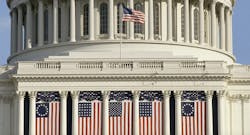NAHB Chairman's Letter: Finding Common Ground
Our country underwent a notable transformation in January, ushering in a new president and a new Congress. While some in our industry are cautious about a new administration, the goal of the National Association of Home Builders (NAHB) has not wavered. We will continue to work to make housing more affordable to families across the economic spectrum.
At NAHB, we look at the new political landscape as an opportunity to find common ground in the effort to create more jobs and expand our economic recovery. Our mission has always been to help our members achieve professional success as they build the American dream, no matter what political party has control in Washington.
As we like to say, we are not Republicans or Democrats. We’re Housers.
Advocating for Policies That Support Housing
The residential construction sector has been a key bright spot in the economy, and one of the few industries delivering jobs and economic growth during the COVID-19 pandemic.
But in order to continue to lead the economic recovery, federal lawmakers and other policymakers must put in place policies that foster support for housing. Our nation has not enacted a holistic national housing policy since 1990, and we are working to plant the seeds that will yield such legislation.
Systemic labor shortages continue to rank at the top of any list of significant problems that contribute to rising costs in construction. And domestic workforce development efforts are not generating the number of workers needed to address these gaps.
We are excited to work with legislators to promote job training programs that prepare individuals for home building careers. In addition, we hope to see immigration policies that complement ongoing vocational training efforts and can help fill labor gaps while continuing to protect the nation’s borders.
Key to improving supply and reducing affordability challenges is lessening regulatory burdens that add new costs.
Both efforts can help ease severe labor shortages that strain the industry’s ability to keep the economy growing. Housing can also serve as a home for individuals from other industries, like the service sector, that have been adversely affected by job losses during the pandemic.
As a long-time leader in housing innovation, NAHB also will work to address climate change—a definite priority of the new administration. We aim to tilt the focus away from mandated energy efficiency requirements on new homes that already follow modern codes for efficiency and resiliency toward improving older homes, structures, and infrastructure, and to maintain the use of voluntary consensus codes and standards for the industry. State and local governments must also have maximum flexibility to amend building codes so they can address specific geographic and economic needs.
Key to improving supply and reducing affordability challenges is lessening regulatory burdens that add new costs to an already undersupplied market and ultimately price out thousands of households from homeownership and rental housing.
We also are working to advance a tax credit targeting lower- and middle-income Americans; enhance the Low-Income Housing Tax Credit to promote the construction of sorely needed rental apartments; and achieve comprehensive housing finance reform that maintains a limited federal backstop and ensures the availability of reasonably priced mortgage credit in all economic conditions.
Safe, decent, and affordable housing is a fundamental need, and NAHB looks forward to working with the new administration and key policymakers in Washington and across the nation to advance policies that focus on expanding housing opportunity for all.
W2W4 at NAHB
- Looking for a greater understanding of the latest housing industry data? Want to know what the numbers mean for the industry? NAHB economists offer detailed analysis of the latest government data, including housing starts, sales, GDP, CPI, jobless claims, and more. Monthly surveys like the NAHB/Wells Fargo Housing Market Index (HMI) take the pulse of the single-family housing market. Find out more at EyeOnHousing.org
- NAHB’s educational programs focus on practical industry training for both newcomers and veterans. Dozens of educational courses and seminars are tailored for your needs as a building professional and focus on ideas and strategies you can use every day to improve your business and advance your career. Use our Education Calendar to find upcoming opportunities to attend classes in your local area or learn online at your own pace.

